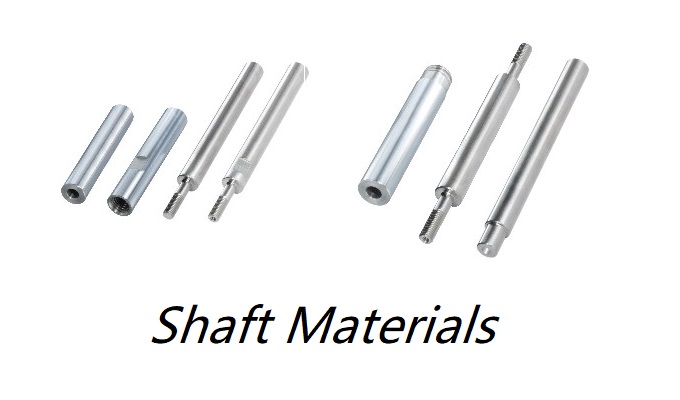What is a Linear Shaft?
A linear shaft, also known as a linear guide shaft or linear motion shaft, is a critical component in various mechanical systems to enable linear motion. One or both ends of the linear shaft often have mounting features, such as threads or keyways, to connect it to other components or systems. Bearings, linear guides, or sliding systems are used with the linear shaft to facilitate smooth and controlled linear motion.
Linear shafts come in various diameters and lengths to accommodate different applications and loads
Linear shaft
What is a Rotary Shaft?
A rotary shaft, also known as a shaft or a rotational shaft, is a mechanical component used to transmit rotary motion or torque in machines and mechanical systems. Unlike the linear shaft that enables linear motion, the rotary shaft facilitates rotational motion around its central axis.
One or both ends of the rotary shaft may be designed with keyways, splines, or threads to connect it to other rotating components, such as gears, pulleys, sprockets, or couplings. These connections allow the rotary shaft to transfer torque and rotational motion to other parts of the machine or system.
Rotary Shaft
What is the Difference Between a Linear Shaft and a Rotary Shaft?
|
Features |
Linear Shaft |
Rotary Shaft |
|
Motion Type |
||
|
Structural Form |
Straight rod or guide rail |
Cylindrical |
|
Motion Control |
Guide rail, slider, etc. |
Motor, transmission, etc. |
|
Application |
CNC machine tools, handling equipment |
Motor-driven devices, fans, pumps, etc. |
|
Power Transmission |
External power transmission (electric or hydraulic) |
Electric, mechanical transmission, etc. |
|
Surface Treatment |
Hard chrome plating, heat treatment, coating, etc. |
Polishing, metal plating, coating, etc. |
Linear axes achieve linear motion; common structural forms include straight rods or guide rails. Guide rails, sliders, etc., control linear motion. Linear axes are widely used in fields requiring linear motion, such as CNC machine tools and handling equipment. What the rotary shaft realizes is rotary motion, and its structural form is cylindrical. Rotary shafts usually achieve rotational motion through motors, transmissions, etc. They are mainly used in equipment with rotating motion, such as motor drives, fans, pumps, etc.
Linear axes typically rely on external power transfer systems, such as electric or hydraulic, to achieve linear motion. The rotating shaft is usually driven by a motor or other rotating power source, and the power is transmitted to the shaft through the transmission device to realize the rotating motion.
Both linear and rotary axes may have a surface treatment, but there are differences in how they are treated. For example, a linear axis might be hard chromed, heat treated, coated, etc., while a rotary axis might be polished, metalized, coated, etc.
How to Choose the Right Shaft?
When selecting a Linear Shaft vs. Rotary Shaft, several factors need to be considered to ensure that the needs and requirements of a specific application are met. The following are key factors that should be considered when choosing between these two axes:
Considerations when selecting a linear axis
1. Shaft Diameter and Length: Select the appropriate linear shaft diameter and length based on the required load, application space, and range of linear motion. Larger shaft diameters and lengths generally provide greater rigidity and load-carrying capacity.
2. Material: According to the application environment, load, and working conditions, select the appropriate linear shaft material, such as carbon steel, alloy steel, stainless steel, or ceramics. Make sure the selected material has sufficient strength and wear resistance.
3. Motion control: Determine the required motion control methods, including guide rails, sliders, linear bearings, etc., to ensure smooth and precise motion of the linear axis.
4. Surface treatment: According to the special needs of the application, choose the appropriate surface treatment method, such as hard chrome plating, heat treatment, or coating, to improve wear resistance and reduce friction.
5. Load and speed: Evaluate the required load capacity and speed of motion of the linear axis to ensure that the selected axis will meet the operating requirements of the application.
Considerations when selecting an axis of rotation
1. Shaft Diameter and Length: Select the proper diameter and length of the rotary shaft based on the required torque, application space, and range of rotary motion. Larger shaft diameters and lengths generally provide greater rigidity and torque transmission capabilities.
2. Material: According to the application environment, torque, and working conditions, select the appropriate rotating shaft material, such as carbon steel, alloy steel, stainless steel, or copper alloy. Make sure the selected material has sufficient strength and wear resistance.
3. Motion Control: Determine the motion control required, including bearings, plain bearings, or other support structures, to ensure smooth and precise rotational motion of the rotating shaft.
4. Surface treatment: According to the special needs of the application, choose the appropriate surface treatment method, such as polishing, metal plating, or coating, to improve wear resistance and reduce friction.
5. Torque and speed: Evaluate the required torque transmission capability and rotational speed of the rotating shaft to ensure that the selected shaft will meet the working requirements of the application.
In conclusion, when selecting linear and rotary axes, the key is to understand the specific application's requirements, including loads, motion patterns, environmental conditions, and expected performance. By comprehensively considering these factors, the most suitable linear and rotary axes can be selected to ensure the performance and reliability of the mechanical system. If you have any questions or needs, please get in touch with Yiheda's official sales staff.
Conclusion
Understanding the differences between linear and rotary shafts is essential for selecting the right shaft type for a specific application. By considering the motion requirements, load capacity, environmental conditions, and other factors, engineers can make informed decisions and optimize the performance and efficiency of mechanical systems. Whether achieving precise linear motion or reliable rotational motion, the appropriate choice of the shaft will significantly impact the overall functionality and reliability of the machinery.







